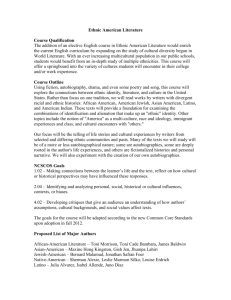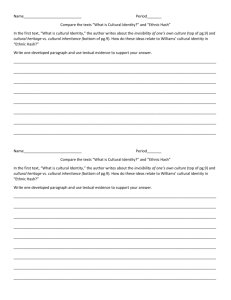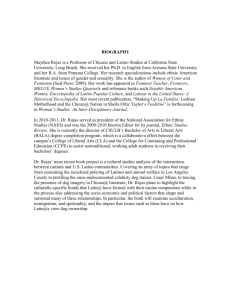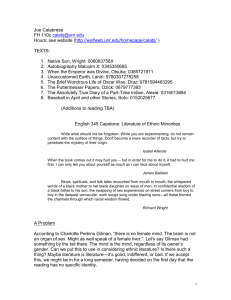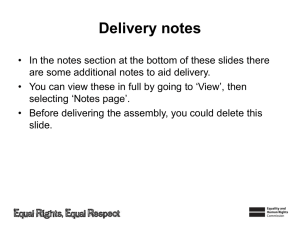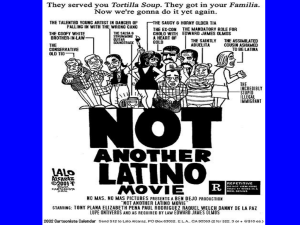Proposal pt1
advertisement
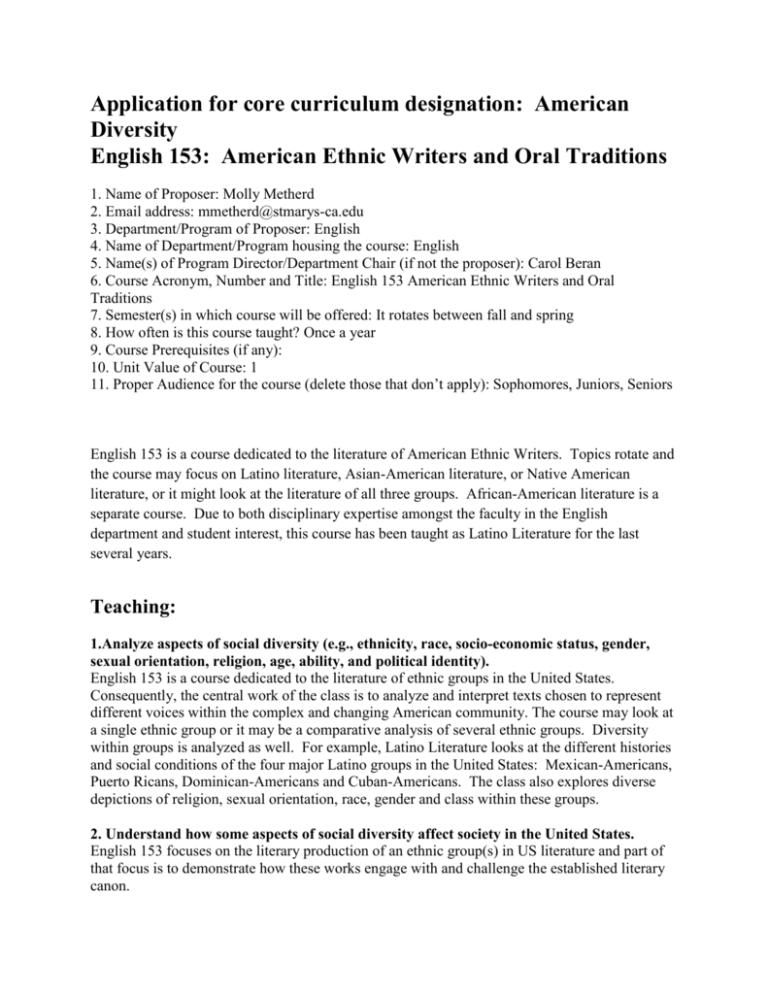
Application for core curriculum designation: American Diversity English 153: American Ethnic Writers and Oral Traditions 1. Name of Proposer: Molly Metherd 2. Email address: mmetherd@stmarys-ca.edu 3. Department/Program of Proposer: English 4. Name of Department/Program housing the course: English 5. Name(s) of Program Director/Department Chair (if not the proposer): Carol Beran 6. Course Acronym, Number and Title: English 153 American Ethnic Writers and Oral Traditions 7. Semester(s) in which course will be offered: It rotates between fall and spring 8. How often is this course taught? Once a year 9. Course Prerequisites (if any): 10. Unit Value of Course: 1 11. Proper Audience for the course (delete those that don’t apply): Sophomores, Juniors, Seniors English 153 is a course dedicated to the literature of American Ethnic Writers. Topics rotate and the course may focus on Latino literature, Asian-American literature, or Native American literature, or it might look at the literature of all three groups. African-American literature is a separate course. Due to both disciplinary expertise amongst the faculty in the English department and student interest, this course has been taught as Latino Literature for the last several years. Teaching: 1.Analyze aspects of social diversity (e.g., ethnicity, race, socio-economic status, gender, sexual orientation, religion, age, ability, and political identity). English 153 is a course dedicated to the literature of ethnic groups in the United States. Consequently, the central work of the class is to analyze and interpret texts chosen to represent different voices within the complex and changing American community. The course may look at a single ethnic group or it may be a comparative analysis of several ethnic groups. Diversity within groups is analyzed as well. For example, Latino Literature looks at the different histories and social conditions of the four major Latino groups in the United States: Mexican-Americans, Puerto Ricans, Dominican-Americans and Cuban-Americans. The class also explores diverse depictions of religion, sexual orientation, race, gender and class within these groups. 2. Understand how some aspects of social diversity affect society in the United States. English 153 focuses on the literary production of an ethnic group(s) in US literature and part of that focus is to demonstrate how these works engage with and challenge the established literary canon. What is more, all of the texts we read, whether the course is being taught as Latino Literature, Native American Literature, or Asian-American Literature, have characters and settings that reveal the social diversity of the United States. Whether the class is reading Louise Erdrich’s novel Love Medicine, which depicts the lives of a small group of Chippewa living on the Turtle Creek Reservation in North Dakota, or Tomás Rivera’s text And the Earth Did Not Devour Him, which tells the story of a community of Mexican-American farmworkers in the Southwest, or Tato Laviera’s poem, “AmeRícan” which celebrates the experience of being Puerto Rican in New York City, the students are examining how diverse characters and communities shape contemporary realities of the United States. 3. Explain how social categories may affect the human person. The central theme of the course is the formation of identity within a particular social context. The texts we read depict fictional and real characters encountering the dominant US culture in a variety of ways: in public places like the classroom, the city streets, the courtroom, or the political march, and in private ways in relationships between employers and employees, between friends, and between lovers. They explore the ways in which individuals internalize the messages of the dominant culture and how these messages often conflict with those of their own culture(s). 4. Explain how structures of power may affect the human person. The social categories that shape the different voices in English 153 inevitably imply structures of power. For example, Cristina Garcia’s novel Dreaming in Cuban explores how the physical borders between Cuba and the United States created emotional borders within families. Cherrie Moraga’s text Loving in the War Years argues that the narrator’s brother has more access to privilege and power than she does as a woman and a lesbian. Junot Diaz’s novel The Brief and Wonderous Life of Oscar Wao examines the ways in which Dominican depictions of oversexualized masculinity do violence to the protagonist who does not conform to those stereotypes. Learning: how coursework will be used to measure student learning of the outcomes: 1.Students are able to thoughtfully analyze aspects of social diversity (e.g., ethnicity, race, social-economic status, gender, sexual orientation, religion, age, ability, political identity). The course is conducted as a discussion. During each class meeting, students are expected to demonstrate in discussion that they have read carefully, noting relevant details of the text under study. Each text we read depicts some aspect of diversity in the United States. In addition, students are expected to submit regular, informal writing assignments (weekly response papers, blogs, journal exercises, and/or in-class writing) in which they look at the diverse settings and characters more closely. 2. Students are able to demonstrate understanding of how aspects of social diversity affect society in the United States of America. In weekly informal writing assignments students will be assessed on how they understand the texts within the context of the American experience as a whole. For example, in one blog post students might reflect on the changing ethnic and racial make-up of a city like New York as it is depicted in a novel that spans several generations and then discuss the protagonist’s response to those changes. In another post, students might discuss how they themselves have experienced social diversity. A final exam made up of shorter essay questions will be used to assess the student’s understanding of the different social situations and how they appear in different ways in the United States. For example, students might be asked to analyze a series of significant passages to discuss how each passage is a carefully crafted response to dominant representations of American character and identity. 3. Students are able to explain how social categories may affect the human person. This will be achieved in brief writing assignments and in formal essays. Students analyze the ways the texts describe the social worlds of their characters, interrogate structures of power, and explore how these structures have implications for the lives of the characters and the students’ own lives. Students might make personal connections in the weekly writing assignments. In longer essays, students might look at the conflict of Henry Reyna in Luis Valdez’s film Zoot Suit who tries to find his sense of self despite the media and police stereotypes of him as a violent Chicano gang member. Or they might choose to write on how Jing-Mei, the protagonist in The Joy Luck Club confronts and negotiates differing Chinese and US notions of gender roles. 4. Students are able to explain how structures of power affect the human person. This will be assessed on the final exam. In each, students will be expected to discuss the structures of power that, in American society, inevitably accompany difference. For example, an essay on the exam might ask students to explain how the presence of a military base on the US/Mexico border regulates and organizes daily life for the characters in Rolando Hinojosa’s short story “The Hammon and the Beans” Another essay question might ask students to briefly discuss the consequences of the nuns visit to the home of Richard Rodriguez, which he describes in his memoir Hunger of Memory, where they tell his parents to stop speaking Spanish at home.
